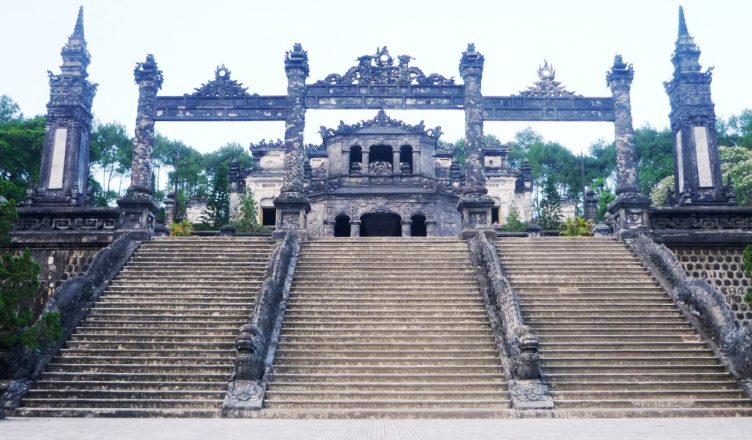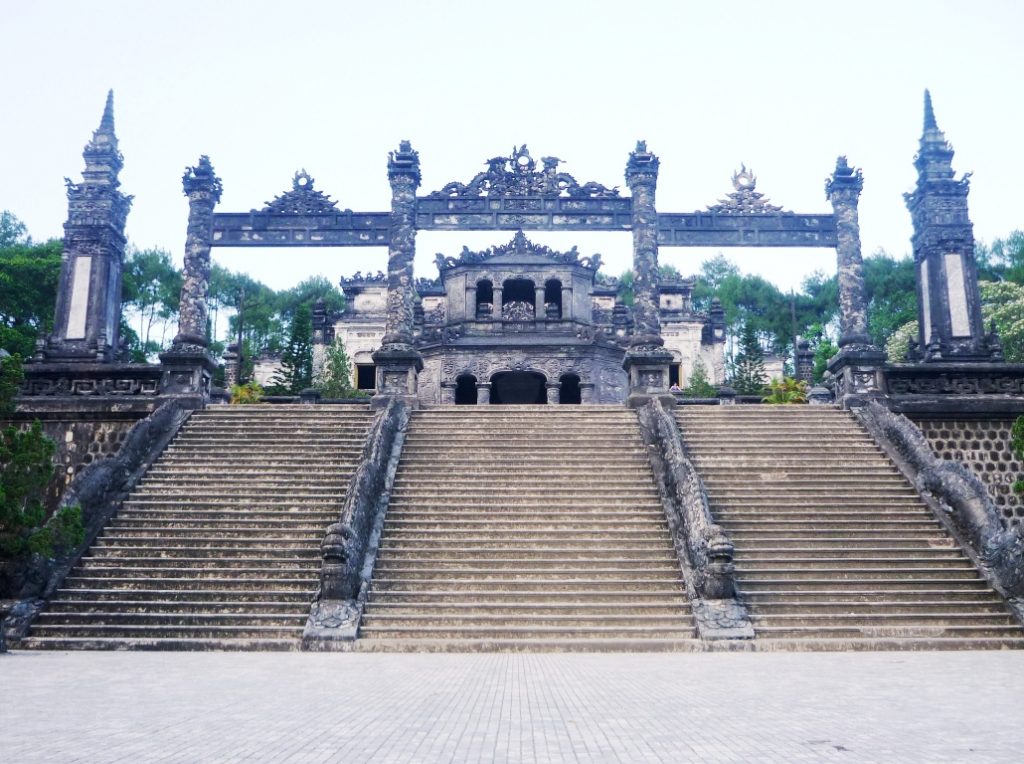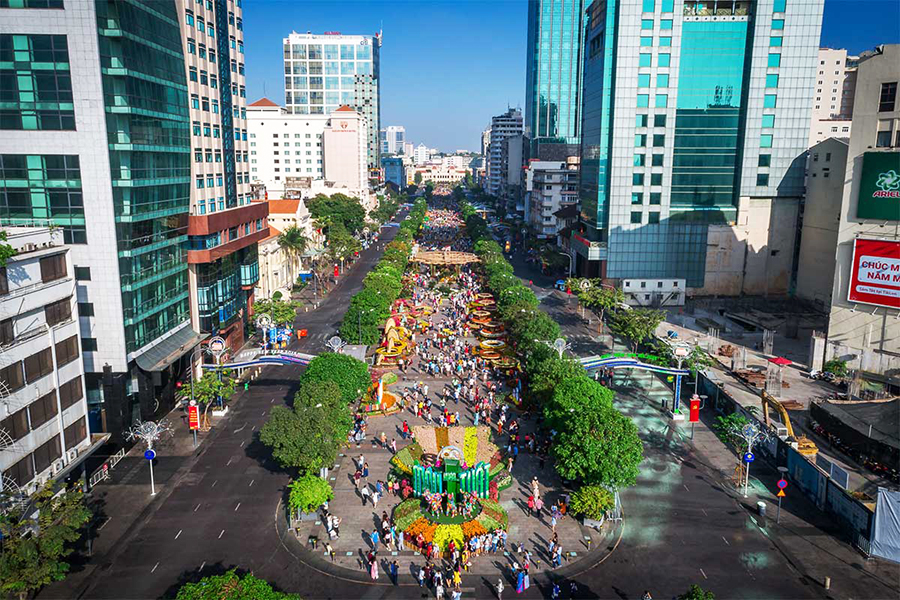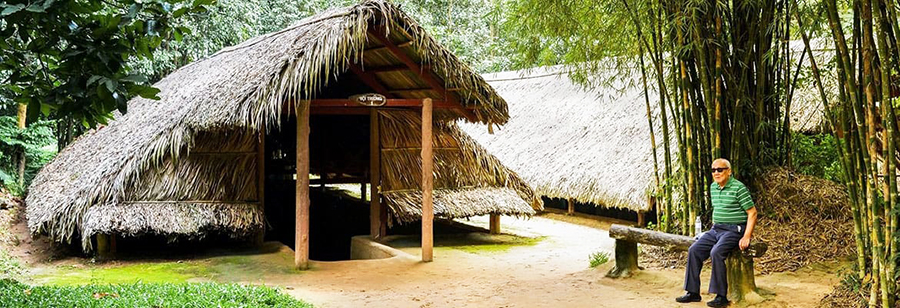Khai Dinh Tomb, officially known as the Ung Mausoleum, or Royal Tomb of Khai Dinh King is situated in Chau Chu Mountain, about 10km away from Hue city, Vietnam. The tomb of Khai Dinh is the smallest, but most costly and recent one in comparison with other tombs of Nguyen royals. It was established by Emperor Khai Dinh, the 12th Emperor of the Nguyen Dynasty, during the period from 1920 to 1931. This 11-year-to-complete tomb is located on a hillside and has a combination of Eastern and Western style in terms of architecture. Khai Dinh Tomb is considered one of the most worth-visiting Hue attractions. Join Vietnam Shore Excursions to understand more about the Khai Dinh Royal Tomb.
History of Khai Dinh Tomb
Khai Dinh became Vietnam’s penultimate emperor from 1916 to 1925, but was not popular amongst Vietnamese people due to his close collaboration with the government of France (he was widely seen as a puppet of the French).
Similar to some Vietnamese emperors, Khai Dinh also prepared a tomb carefully in anticipation of his death. The monument was impacted strongly by French architecture style, shown through the Oriental mausoleum, as the most noticeable proof of this European influence. To be able to complete the mausoleum, the principles had to increase the national tax to 30%. This tomb was accomplished in 1931 by Bao Dai, the successor of Khai Dinh.
Best Time to Visit Khai Dinh Tomb
Tourists can visit Khai Dinh Tomb all year round. The ticket price is even free during big holidays like National Day (September 2nd) and the first of Lunar New Year.
Khai Dinh Tomb Architecture
The tomb is a rectangular monument leaning against Chau Chu Mountain in the rural area of Hue city. Built from modern materials like slates, concrete and wrought iron, the tomb has a relatively gray and imposing appearance.
Inside the tomb, side walls are featured with the biggest sculptures of dragons throughout Vietnam.
Most of the grandiose exterior of the tomb is covered in the weathered, darkened concrete, with an unexpectedly Gothic air. In contrast, the interiors look like explosions of colorful ceramic mosaics.
Stepping into the Honour Courtyard, you will see many mandarin honour guards with a mixture of European and Vietnamese features. Going up further 3 flights of stairs, you will head to the most notable place of the tomb named Thien Dinh palace, the stupendous main building, with the ceiling and walls decorated with murals of the Four Seasons, Eight Precious Objects and the Eight Immortals.
Below the graceless, gold-speckled concrete canopy, there is a gilt bronze statue of the King Khai Dinh, who was thought to have homosexual despite the fact that he produced an heir. The remains of the King were interred about 18 meters below the statue.
Indeed, the hard, isolated materials, through the skillful hands of artisans, have become vivid, soft and brilliant works of art.
All of the decoration inside Thien Dinh not only reflects the cultural and art values, but also represents the concept of the establishment and the idea of the King. In addition to the decorative items drawn from Confucian texts and royal life, there are also Taoist decorations, particularly hundreds of swastikas, a symbol of the Buddha, produced by the green glass.
Artist Phan Van Tanh was the main person responsible for the creation of the masterpieces of art in Khai Dinh mausoleum. He was also the author of the three largest murals in Vietnam, “Cuu Long an van” (Nine dragons amidst fleeting clouds) decorated under the ceiling of the three middle houses of Thien Dinh palace.
- You may be interested in our Hue Tour from Da Nang, Hue to Hoi An Jeep Tour, Hue Street Food Tour, and DMZ Tour Hue.
What to See and Do at the Tomb of Minh Mang?
The Khai Dinh Tomb in Hue is known for its unique blend of traditional Vietnamese, Chinese, French and other architectural styles. The tomb blends oriental and occidental influences with its elaborate stone carvings, ceramic mosaics and gold leaf embellishments. Therefore, Khai Dinh’s tomb is the pinnacle of the Hue royal tombs architecture.
The First Gate With 38 Ladder Steps
To get entry to the iron gate of Khai Dinh tomb Vietnam, you must first walk 38 ladder steps. You will see the pillars at this gate are built in the Hindu style. That shows the unique cultural and architectural interference between Vietnam and India.
One remarkable thing is four dragons lying beside the steps, forming a beautiful set of banisters. In addition, other ladder steps in the tomb also have this.
Once passing the gate, you will enter the first courtyard featuring traditional mandarins’ working buildings made of reinforced concrete on the left and right.
Tam Quan Gate With 29 Ladder Steps
Tam Quan Gate stands out with its majestic and superficial architecture, which is the main entrance to get deep inside the tomb of Khai Dinh. You will need to walk through the 67 ladder steps and the first courtyard to get to the Tam Quan gate.
The Tam Quan gate to the tomb is especially impressive, with a large stone gate adorned with dragons and phoenixes that symbolize power and good luck. Hence, many people take photos at this gate to save memory.
Nghi Mon And Bai Dinh Courtyard
After 29 steps to the Tam Quan Gate, you will reach the Nghi Mon area and Bai Dinh courtyard. There, you will be overwhelmed when admiring statues of courtiers and soldiers lined up in four symmetrical rows. That is like recreating the adoration scene for the emperor during the reign of the Khai Dinh emperor.
Khai Dinh Tomb has 24 stone statues of mandarins, martial arts officials, servants, elephants, and horses that are delicately crafted in a ratio of 1:1. That is a fancy combination among rows of stone statues and pillars bearing the imprint of Indian architecture.
According to the old view, outside the tombs of the emperors, there must be many images of soldiers, horses, and courtiers. They must follow the emperor to help the emperor continue to rule the country when going to the afterlife.
Stone Stele Pavilion
Bi Dinh of Ung Lang is an octagonal communal house containing a stone stele 3.1 m in height. Inside the octagonal pavilion is a ten-ton massive stele engraving the Khai Dinh emperor’s biography and achievements. His son, Emperor Bao Dai, constructed it to honor his father.
The two left, and right sides of Bi Dinh are two Bieu pillars, symbolizing the two candles illuminating the emperor’s soul in the afterlife.
Thien Dinh Palace
Continue going up to the highest floor in the mausoleum; you will enter Thien Dinh Palace. It is the main architecture of the mausoleum. This is the place with the unique design with 5 consecutive parts, including two sides Ta, Huu Truc room, Khai Thanh palace, and in the middle is Bửu Tán.
Outside the Thien Dinh Palace
In addition to the large altar completely inlaid with crockery, inside the mausoleum, there is also a small canopy (Buu Tan or parasol) above the bronze statue of Khai Dinh emperor. The parasol with 99 dragons guarding the emperor in all directions. Besides, there is a Sunset emblem right behind his back. It means the emperor has already passed away.
The whole parasol is a reinforced concrete block weighing nearly 1 ton. However, the beautiful ceramic mosaic art makes the viewer feel like it is made of silks with soft, elegant and graceful curves, vivid that can move in the wind. Thus, it is a masterpiece of ceramic mosaic art.
Inside the palace, there are two bronze statues of the emperor. It is the only mausoleum with a king statue of the Nguyen Dynasty in Hue. Two statues inside the Khai Dinh Tomb of Hue include one sitting on the throne in Thien Dinh Palace and one standing statue on the left of Khai Thanh palace.
A clock in Thien Dinh palace
Underneath the parasol is a bronze statue of Khai Dinh cast in France in 1920 by two Frenchmen. They were P. Ducing and F. Barbedienne at the request of emperor Khai Dinh. Afterward, the Hue artisans made the gold inlaid part. Underneath the statue’s base is where the coffin and King’s body are put in 9m depth.
Khai Thanh Palace
The two sides are Ta and Huu Truc compartments for soldiers guarding the Khai Dinh Tomb. In front is Khai Thanh Palace, where there is an altar and a portrait of Khai Dinh emperor.
If the exterior is decorated with patterns and motifs of dragons, phoenixes, birds, and flowers… embossed with cement on the dominant white tone, the palace’s interior is a different world. Inside the palace, porcelain mosaic art and painting are at a level of unparalleled virtuosity with fabulous beauty.
The entire interior of the palace is decorated with reliefs made of porcelain and glass. Those are the paintings of the four quarters, eight treasures, five blessings, tea trays, crowns, etc. Even modern items such as tennis rackets and kerosene lamps… are also decorated here.
The artist Phan Van Tanh is mainly responsible for creating masterpieces in Khai Dinh Tomb. He painted the three largest “Cuu Long An Van” murals in Vietnam decorated on the tomb’s ceiling in Khai Thanh Thien Dinh palaces.
It is the only ceiling painting that still exists in Vietnam so far. “Nine Dragons hidden in the clouds” was painted by the artist Phan Van Tanh’s feet. Hence, the ceiling painting is one of the most special parts of the Tomb of Khai Dinh.
Also, the standing statue was cast in Hue by a native worker of Quang Nam. It was originally in An Dinh Palace and was moved to Thien Dinh Palace in 1975. A life-size bronze statue (160 cm tall) depicting a martial-looking Khai Dinh in full regalia clutching a sword.
The chambers for the guardians who guarded the tomb are on the right and left sides of Khai Thanh palace. They are now a small museum including many images and mementos of the Khai Dinh Emperor.
Khai Dinh Tomb Entrance Fee
The Khai Dinh Tomb is open daily to visitors from 7:00 am to 5:00 pm. To visit the mausoleum, you must buy an entrance ticket to visit the tomb and contribute to preserving this world heritage site.
- Adults: 150,000 VND / person
- Children (from 7-12 years old): 30,000 VND/person/
- Children under 6 years old: Free
Khai Dinh Tomb Map
How to Get to Khai Dinh Tomb?
Khai Dinh tomb is 10km away from Hue city center. Unlike Minh Mang Tomb and Tu Duc Tomb, which can be accessed by boat, Khai Dinh Tomb is a little away from the river; therefore, it is better to get there by road. Nonetheless, you can still get there by boat, but it takes about 45 minutes. If you are short on time, you can get to Khai Dinh Tomb by taxi and motorbike taxi. But the best way is to book Hue City Private Tour with a local private tour guide via Vietnam Shore Excursions.
Travel Tips to The Tomb of Emperor Khai Dinh
When visiting the Khai Dinh Tomb, wear comfortable shoes, as the site is on a hill and includes many ladder steps. Visitors should also be respectful of the site and avoid touching any artifacts or decorations. Finally, bringing plenty of water is a good idea, as the site can get hot and sunny during the day.

























